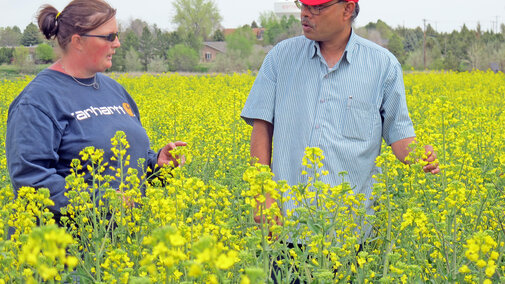May flowers aren’t the only plants blooming in western Nebraska.
Most irrigated row crops won’t emerge for weeks, but winter canola began blooming in early May in the research plots at the Panhandle Research and Extension Center, creating a bright yellow patch that catches the eye of travelers driving by on Highway 71 on the north edge of Scottsbluff.
According to Dipak Santra, alternative crops breeding specialist at the Panhandle Center, the plots are part of a five-state project, Development and Management of Winter Canola in Great Plains Region. It is funded by a USDA National Institute of Food and Agriculture (NIFA) grant under the Supplemental and Alternative Crops Competitive Grant Program.
The plot consists of the Great Plains Canola variety trials (36 varieties), National Winter Canola Variety Trials (24 open-pollinated varieties and 24 hybrids), and Early Generation breeding population trials. The last trial is testing 120 f2 populations (the second filial generation of a cross breed).
Plant lines will be selected for further crosses according to desirable traits: winter survival, flowering, maturity, shattering tolerance, and overall plant appearance.
The canola is expected to be harvested around the end of June, a bit earlier than the normal mid-July harvest.
The project is intended to help identify well-adapted winter canola varieties to produce high seed yield and oil content; winter hardy lines for western Nebraska; and the best approach for seeding winter canola in both dryland and irrigated systems in western Nebraska.
The ultimate long-term goal of these trials and Santra’s canola research is to position winter canola as an alternative rotational crop, especially in dryland crop production systems in western Nebraska. Currently there is no fall-planted broadleaf crop to rotate into winter wheat production systems.
“The hope is once winter canola is incorporated in winter wheat production systems, the crop production in western Nebraska will be sustainable and wheat yield will improve,” Santra said.
The project’s overall, long-term goal is to facilitate adaptation of winter canola as an agronomically and economically viable rotation crop in the southern Great Plains. Other partners in the regional variety trials include Kansas State University (the lead institution), Colorado State University, New Mexico State University, and Texas A&M University.
The goal of the Scottsbluff plots is to develop and identify varieties suitable for the High Plains of Nebraska. Cultivars suited to the southern states will not tolerate western Nebraska’s very cold winters with no snow cover, as well as high wind.
Santra said Nebraska has no officially reported winter canola acreage, although some farmers test plant 25 to 50 acres from time to time, primarily in Deuel and Cheyenne counties in the southern Panhandle.
U.S. consumption of canola oil has risen in recent decades, increasing from 800 million pounds in 1991-92 to 5.2 billion pounds in 2014-15, about 3.6 billion pounds of which is imported. With domestic production supplying only 33% of canola oil consumption, there’s a need and opportunity to increase U.S. canola production, Santra said.
Canola could be beneficial in the crop rotation for Nebraska’s dryland wheat farmers, Santra said.
“Winter canola has great potential for improving and increasing small grain cropping system sustainability and profitability in southern Great Plains and western Nebraska.”
Sometimes hard red winter wheat is grown season after season, without other crops in the rotation, increasing problems associated with weeds, soil-borne diseases, and insects. As a result, long-term yield trends in winter wheat yields have not kept up with other crops such as corn and soybeans, he said.
Producers need reliable winter (fall-planted) broadleaf crops that can be grown in rotation with winter wheat to enhance yield and grain quality from rotation effects. Santra said winter canola may disturb the life cycle of wheat stem sawfly, a recently emerged threat to wheat in the Panhandle, reducing its impact in wheat production. Winter canola is immune to stem sawfly.
Winter canola also leaves more water for the following winter wheat crop under dryland production systems, compared to traditional rotation crops such as sunflower and corn. This is because winter canola meets most of its water need by using stored moisture from winter and spring precipitation, leaving summer precipitation for following wheat. Whereas spring- or summer-planted rotation crops (pea, sunflower, corn) use mostly spring and early summer precipitation.
By itself, the availability of high-yielding varieties suitable for western Nebraska will not ensure commercial production in the area, according to Santra. It’s also necessary to develop suitable agronomic production practices. One major problem is getting a good stand in the fall before dormancy, which is hindered by scarce rainfall and dry soil around planting in late August.
Another objective of the canola project is to develop good production and management practices for dryland conditions. This part of the project is being carried out at UNL’s High Plains Ag Lab near Sidney, under the direction of Dryland Cropping Systems Specialist Cody Creech. The goal is to evaluate impacts of fallow period, tillage, and seeding equipment on winter canola establishment.
In the HPAL trials, winter canola is being planted under three tillage treatments: conventional, minimal and no-till on wheat residue using a no-till drill, hoe drill, and row-crop planter.

